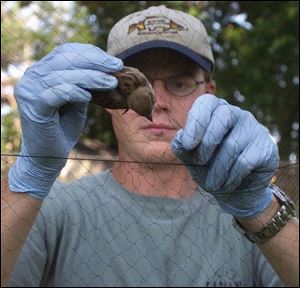
Students help track W. Nile virus
8/9/2001
Tim Driver has captured and drawn blook to test for West Nile virus from hundreds of birds.
Finding the jugular vein in a sparrow isn't that easy.
But Tim Driver is getting pretty good at it.
"We're getting lots of practice," said Mr. Driver as he held a sparrow in his hand and got ready to insert a needle to draw the bird's blood.
Mr. Driver and Lisa Nadasi, both Ohio State Univerisity veterinary students, have drawn the blood of more than 500 birds on behalf of the Ohio Department of Health.
The health department has hired Mr. Driver and Ms. Nadasi to crisscross the state and capture live birds, band them for identification, draw blood samples, and send those samples to the health department's lab in Columbus.
The blood is tested for the presence of the mosquito-borne disease West Nile Virus. The test takes about a day to complete. So far, no birds captured here have tested positive for the virus.
The virus showed up in Ohio for the first time last week after a dead blue jay in northeastern Ohio tested positive for West Nile virus.
Mosquitoes carrying the virus can bite birds, or a mosquito can bite an infected bird. Either way, mosquitoes can then pass the virus on by biting humans. While the virus rarely causes serious problems in people beyond flu-like symptoms, it has killed nine people in the United States since 1999.
Yesterday, Ms. Nadasi and Mr. Driver set up large nets in two locations at the Toledo Zoo. Within minutes, birds began flying into the nets and became tangled. The zoo was chosen because it has a large population of wild birds (not the zoo's birds) flying around and zoo officials have been so helpful, according to Robert A. Restifo, medical ento|mologist with the state health department.
Mr. Restifo said he's sending Mr. Driver and Ms. Nadasi to the larger metropolitan areas in the state this summer to do the testing. The two began capturing birds on July 23 and so far have captured and tested almost 600 birds, mostly sparrows.
The two have the bird testing down to a well-honed routine. Yesterday morning, birds flew into the nets every few minutes. Mr. Driver or Ms. Nadasi untangled the bird from the nets, gently located the bird's jugular vein, inserted a small needle, withdrew a small amount of blood, and then released the bird. The whole process took a minute or two at most. The two were in Hancock County Monday and Wood County Tuesday. The zoo is their last stop in northwest Ohio for awhile.
This is the second year in a row the health department has done live bird testing - yesterday Ms. Nadasi recaptured a bird that was caught last year in Toledo - but the state used to test birds on a much larger scale in the 1970s and 1980s. At that time, the state sent out eight two-person teams.